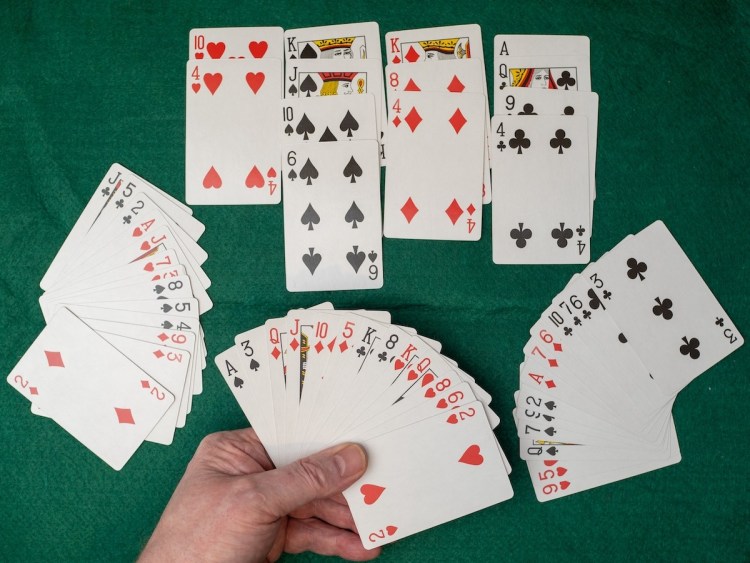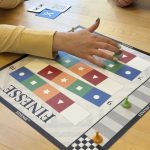Bridge is a card game played with a regular deck of 52 cards and loved by millions around the world.
What is the game of bridge?

What is the game of bridge?
by Jude Goodwin
In it’s simplest form, the game of bridge is a whist-like card game played with a single deck of 52 playing cards (no jokers) and four people who make up two partnerships. It is played in three basic stages:
- The bidding
- The play of the cards
- The scoring
This is the first in a series of articles that will attempt to answer some of the most basic questions about our favourite game of cards.
A little bit of history
The card game bridge is rich in history beginning in the 16th century where it evolved from a British game, Whist. It underwent significant transformations in the 19th and 20th centuries, culminating in the version known as Contract Bridge, popularized by Harold Vanderbilt in the 1920s. This evolution marked a shift from a leisurely pastime to a game of intricate strategy and skill which is played by millions of people around the world today.
The game swiftly gained popularity, becoming a staple in social gatherings and clubs. Its appeal transcends generations, establishing itself as not just a game but a cultural phenomenon, uniting people across age groups and backgrounds.
Introducing the Basics of Bridge
Bridge Fundamentals
Bridge is played by four players, forming two partnerships. Using a standard deck of 52 cards, all the cards are dealt with each player ending with a hand of 13 cards. Dealer starts the bidding, which is like an auction, and play moves to the left. Each player can either bid or pass. When there are three passes, the auction is over. The person who won the auction is the ‘Declarer’, the play to their left is ‘On Lead’ and the partner of Declarer becomes the ‘Dummy.’
Bridge Bidding Phase
In bidding, players make a series of declarations, predicting the number of tricks their partnership can win. This phase sets the stage for the game’s strategic depth, as players must assess their hand’s strength, communicate with their partner through bids, and anticipate opponents’ strategies.
The Play of a Bridge Hand
Once the bidding is over the cards are played out. Each player contributes one card to each round – the highest played card wins the trick. Players must follow suit. If a player doesn’t have a card in the suit played, they need to discard a card from another suit, which will never win a trick. Or they can play a trump card, which often does win the trick. Whether there is a trump suit and what it might be is determined in the auction.
If you’ve played a lot of card games, you’re likely quite familiar with trick-taking games already. These include Whist, Hearts and even War (a great game to get kids started playing cards). High card wins the trick!
The Scoring
At the end of each hand, a score is given depending on if the Declarer succeeded in winning all the tricks they bid (a plus score for their side), or did not succeed (a score for the other side). There are bonus scores for achieving different trick totals and playing with certain trumps or without trumps.
There is no room in this article to give you specifics on how to play but we have an excellent page on this site that will help walk you through the basics. We call it the classroom and you can find it here – Learn to Play Bridge
The Enduring Appeal of Bridge – A Game for All Ages
Mental Exercise
Bridge’s appeal lies in its ability to bring together players of all ages. It’s a game that rewards experience and wisdom, making it particularly popular among older adults. In fact, recent studies have proven that playing bridge can help seniors keep their brains sharp and their social skills intact. There is even evidence of bridge as a preventative to dementia. At the same time, its strategic depth and competitive nature attract younger players as well, making it a cross-generational pastime.
Online Convenience
With the advent of online platforms, Bridge has found a new lease of life. These platforms allow players to connect with others worldwide, participate in tournaments, and hone their skills, ensuring that the game continues to thrive in the digital era. You can find many of the world’s most popular platforms on our Play Bridge Online pages. But even better, you can learn to play bridge online as well. Visit our learn to play bridge section for all the links and resources you need.
Get Social
Bridge stands out as a game of intellect, strategy, and partnership. Its lasting popularity attests to its depth and the mental agility it demands from its players. It’s also a social event for most of us! I know I can travel to anywhere on the globe and be able to find a crowd of bridge players who will welcome me with open arms. Recently I was recovering from a difficult break-up and needed to find some friends. So I went back to playing bridge at the local club and everyone was so happy to see me. It felt very good.
For those intrigued by strategic card games, Bridge offers a rich, rewarding experience. It’s a game that challenges the mind, fosters social connections, and provides endless hours of engagement. Whether you are a novice or a seasoned player, Bridge beckons with the promise of a captivating adventure in the world of cards.
Is bridge difficult to learn? Not really. Is bridge a lifelong challenge? Yes. As you play you will continue to hone your skills and improve your game and this will captivate you for a lifetime.








